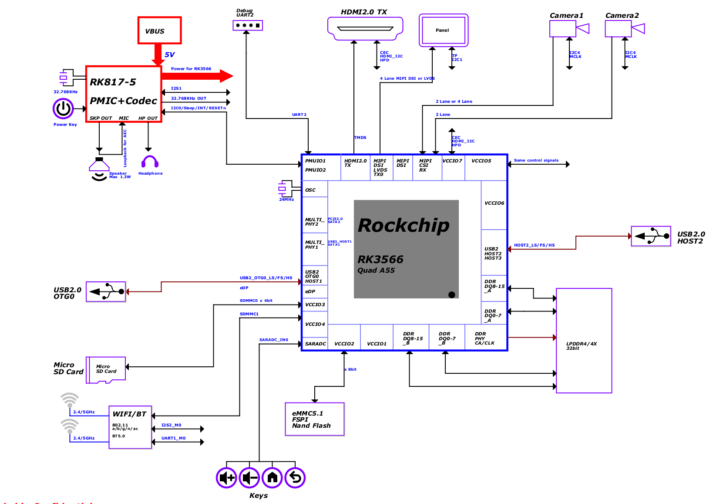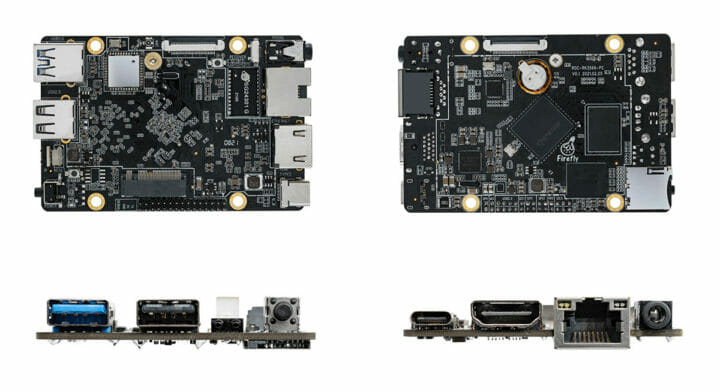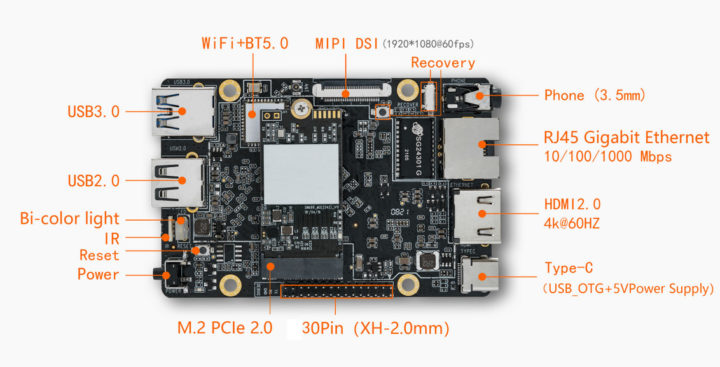Firefly has now launched a Rockchip RK3566 single board computer named ROC-RK3566-PC, following the launch of Station P2 RK3568 mini PC on Indiegogo last March, and the completion of the campaign a few days ago.
The quad-core Cortex-A55 SBC supports up to 8GB ECC memory, up to 128GB flash, M.2 2242 MVMe SSD’s, HDMI 2.0 and MIPI DSI video interfaces, Gigabit Ethernet, and more.
- SoC – RockChip RK3566 quad-core Cortex-A55 @ up to 1.8GHz with Arm Mali-G52 2EE GPU with support for OpenGL ES 1.1/2.0/3.2. OpenCL 2.0. Vulkan 1.1, 0.8 TOPS NPU, 4Kp60 H.265/H.264/VP9 video decoder
- System Memory – 2GB, 4GB, or 8GB LPDDR4 RAM with support for “all-data-link ECC” (TBC: Because the info I have so far is that ECC is supported on RK3568, not on RK3566)
- Storage
- 32GB, 64GB, or 128GB eMMC flash
- M.2 PCIe 2.0 socket for M.2 2242 NVMe SSD
- MicroSD card slot
- Video Output
- 1x HDMI 2.0 up to 4Kp60
- 1x MIPI DSI up to 1080p60 output, or dual-channel MIPI DSI up to 2560x 1440 @ 60fps
- Audio – 3.5mm earphone jack, digital audio via HDMI
- Camera – MIPI-CSI camera interface for up to 8MP camera sensor
- Connectivity
- Gigabit Ethernet low-profile RJ45 connector
- Dual-band WiFi 5 (802.11 a/b/g/n/ac) and Bluetooth 5.0
- USB – 1x USB 3.0 port, 1x USB 2.0 port, 1xUSB Type C OTG port also used for power
- Expansion – 30-pin IO header with I2C, SPI, UART, ADC, PWM, GPIO, I2S, etc. Note: 2.0mm pitch
- Misc – IR receiver, recovery, reset & power keys, dual-color LED
- Power Supply – 5V via USB Type-C port
- Dimensions – 90.0 mm × 60.0 mm
- Temperature Range – Operating: -10°C to 60°C; Storage: -20°C to 70°C
- Humidity -10% to 80%

The company will eventually provide support for Android 11, Ubuntu 18.04?, Buildroot + QT, Station OS, but right now only the Android 11 image and source code, plus the flashing tools for Windows/Linux are available on the Download page, where you’ll also find the schematics and datasheet for the board. Firefly has not linked to it yet, but the board should also support the RKNN Toolkit to enable Caffe/TensorFlow/TFLite/ONNX/PyTorch/Keras/Darknet support using the integrated NPU.

The low-profile Ethernet port is nice for people wanting to design compact clusters, and it’s not found in that many boards, with the only ones I can remember on the top of my head being the Khadas VIM3/VIM3L and earlier VIM boards. The presence of an M.2 slot for NVMe SSD may make it competitive against the Raspberry Pi 4 SBC since the latter could only support USB drives, or through RPI CM4 plus a carrier board.
Two versions of ROC-RK3566-PC SBC are currently sold in limited quantities with the 2GB RAM/32GB storage model going for $75 and the 4GB/32GB variant for $105. Those are promotional prices for the next 30 days, after which the boards will sell for $89 and $119 respectively. The model with 8GB RAM should only come a bit later. If you’d like an affordable single board computer with ECC memory, you may have to wait for ROC-RK3568-PC that is not up for sale just yet.

Jean-Luc started CNX Software in 2010 as a part-time endeavor, before quitting his job as a software engineering manager, and starting to write daily news, and reviews full time later in 2011.
Support CNX Software! Donate via cryptocurrencies, become a Patron on Patreon, or purchase goods on Amazon or Aliexpress





